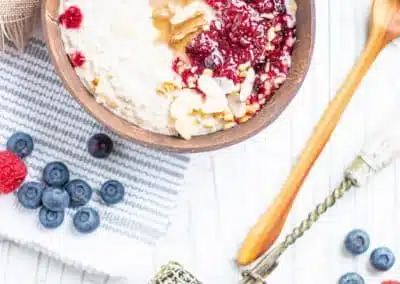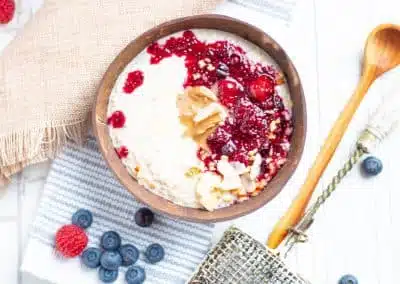Quinoa porridge with warm berries
Porridge is one of the most favorite breakfasts. But every now and then it is nice to have some variety. The pseudo-grain quinoa is also ideal for cooking porridge. Quinoa is also characterized by the fact that it is gluten-free and contains proteins compared to oatmeal. A perfect start for every sensitive tummy. Have you ever tried quinoa porridge? If not, try this delicious recipe for quinoa porridge with warm berries.
LOW-FODMAP
LACTOSE-FREE
GLUTEN-FREE
LOW-FRUCTOSE
Porridge is one of the most favorite breakfasts. But every now and then it is nice to have some variety. The pseudo-grain quinoa is also ideal for cooking porridge. Quinoa is also characterized by the fact that it is gluten-free and contains proteins compared to oatmeal. A perfect start for every sensitive tummy. Have you ever tried quinoa porridge? If not, try this delicious recipe for quinoa porridge with warm berries.
May 19th is the official day of IBD – inflammatory bowel diseases. And as some of you may have heard in my social media, that I will report about anti-inflammatory diet. In the newsletter, I want to share nutritional plans with recipes and anti-inflammatory ingredients, and talk in detail about anti-inflammatory diet. So if you do not want to miss on this, sign up directly in my newsletter (see bar on the right).
So, what makes this recipe an effective anti-inflammatory hero? As I mentioned in my previous posts, certain foods contain elevated levels of bioactive, anti-inflammatory substances:
1) Berries contain a high proportion of phytochemicals, such as anthocyanins. These anthocyanins are responsible not only for the rich, dark color of the berries, studies also prove their anti-oxidative and anti-inflammatory effects. My personal tip: Pay attention to the regular intake of fruits and vegetables and try gradually to increase them step by step in your diet. Because this is how you make sure that you give your body what it needs.
2) Even a sufficient supply of minerals counteract inflammation, this includes in particular the magnesium. Magnesium is included in quinoa, pumpkin seeds, sunflower seeds, as well as spinach, chard, basil or marjoram. My personal tip: Do not always grab magnesium supplements as soon as you have a little leg cramp. These are usually overdosed and may have unwanted side effects, such as diarrhea and other gastrointestinal complaints. Women and men in Germany are generally well nurtured, a vegetable-rich and high-fiber diet saves your wallet.
3) Also, omega-3 fatty acids are among the anti-inflammatory superheroes, for example, the alpha-linolenic acid, which by the way our body can not produce itself, is able to neutralize the pro-inflammatory arachidonic acid. Therefore, you should pay particular attention to their daily intake. Good sources are vegetable oils (especially linseed oil), nuts or fish. My personal tip: I love the nutty taste of linseed oil. That’s why I mix it daily into my yogurt, porridge, protein shake or vegetables. However, their digestibility and tolerability are optimally guaranteed with proteins.
So do not hesitate to get the recipe and enjoy it!
Preparation in min: 35
Calories per serving: 280
Ingredients (for 2 servings):
-
100 g quinoa
-
200 ml coconut milk
-
150 ml water
-
2 EL + 2 EL rice syrup
-
1 TL cinnamon
-
100 g coconut yogurt
-
100 g berries, frozen
-
30 ml orange juice
- 2 TL nut butter (e.g. peanut or almond)
Preparation:
-
Rinse quinoa thoroughly with warm water.
-
Boil quinoa with coconut milk and water. Then simmer over medium heat and with lid until the liquid is absorbed by the quinoa.
-
Season the quinoa with cinnamon and two spoons of syrup. Stir in coconut yoghurt.
-
In the meantime, bring a small pot of berries, juice and syrup to a boil. Then simmer over medium heat until grits arise. If necessary, add syrup to taste.
-
Serve quinoa with berries and nut butter.
Bon Appetit!
About me

Hello, my name is Dominika!
I am a nutritionist and since few years I am specialized in the field of “intestinal health”. Enjoy browsing here!
Follow me
Newsletter
& get my free e-book!

Frequently asked questions
I tried everything. But it is best not to eat at all. Do I take the strain off my gut?
In order to maintain an adequate supply of nutrients, to build up a rich microbiota as well as holistic health, a regular and symptom-oriented diet is necessary. The intestine and its great population need the right foods. Get a professional support along your way and always be patient. Exchange your ideas and wishes with your nutritionist. Or if you need some help, just don’t hesitate to contact me via the form.
I have no identified intolerances. Why do I still not tolerate fresh dairy products or fiber-rich foods?
Fresh dairy products contain higher levels of probiotics than usual, so they can briefly lead to lactose intolerance-like symptoms. The same is true for fiber-rich foods containing prebiotics. The intestine simply has to get used to the new population. Initially, you can relieve your stomach with a combination of vegetables and vegetable oils (such as linseed oil).
Cabbage, beans or fiber are bloating. Is there anything I can do against it?
A varied diet is important, including healthy fats. These relieve the intestine by ensuring that the food stays in the stomach for a longer time. Therefore always combine the meals with vegetable fats. But watch out – also the amount is important. Furthermore, frozen cabbage or beans are normally leading to less bloating.
You may like these posts too
Folge mir auf
Datenschutz | AGB | Impressum | Kontakt




0 Kommentare